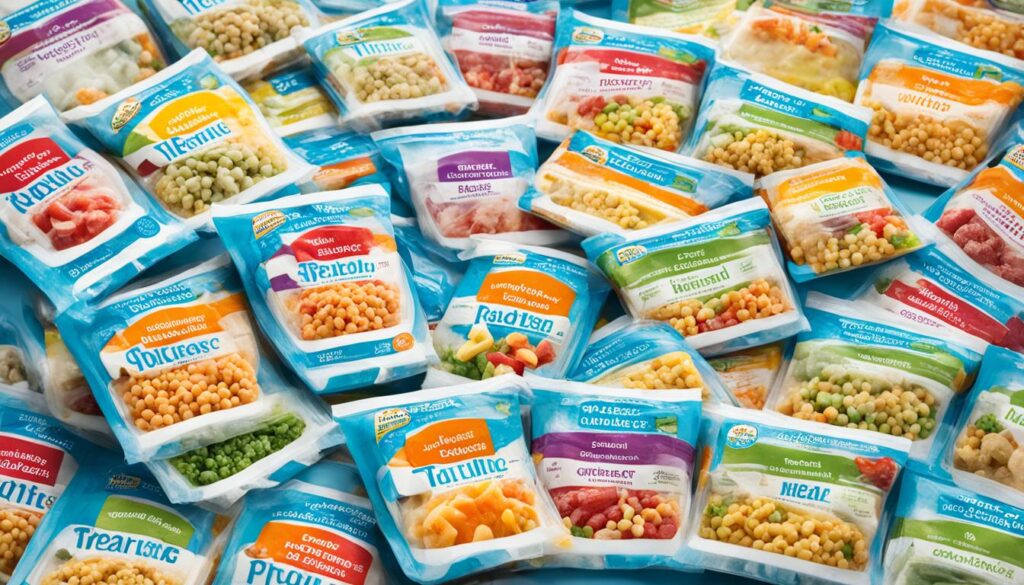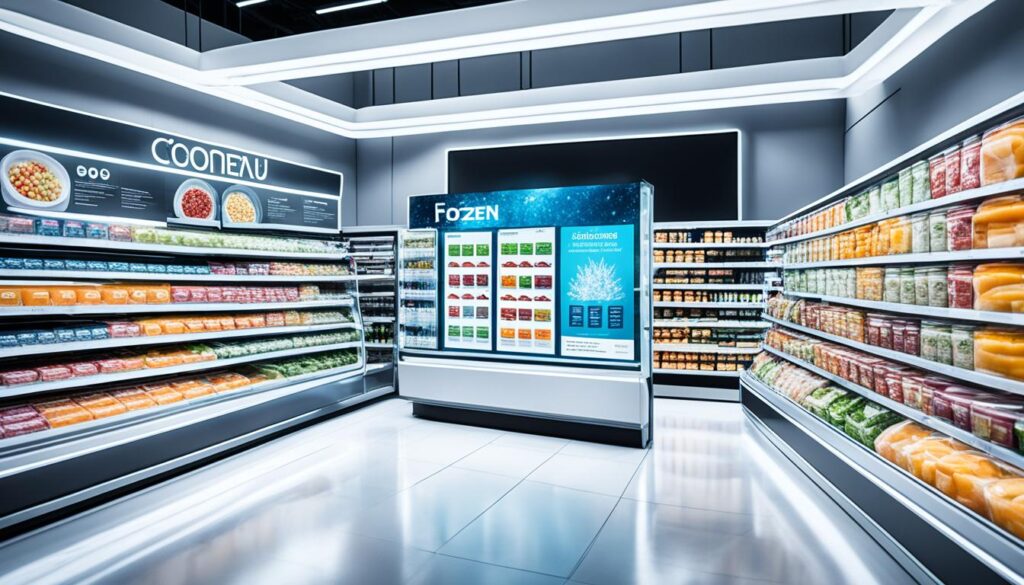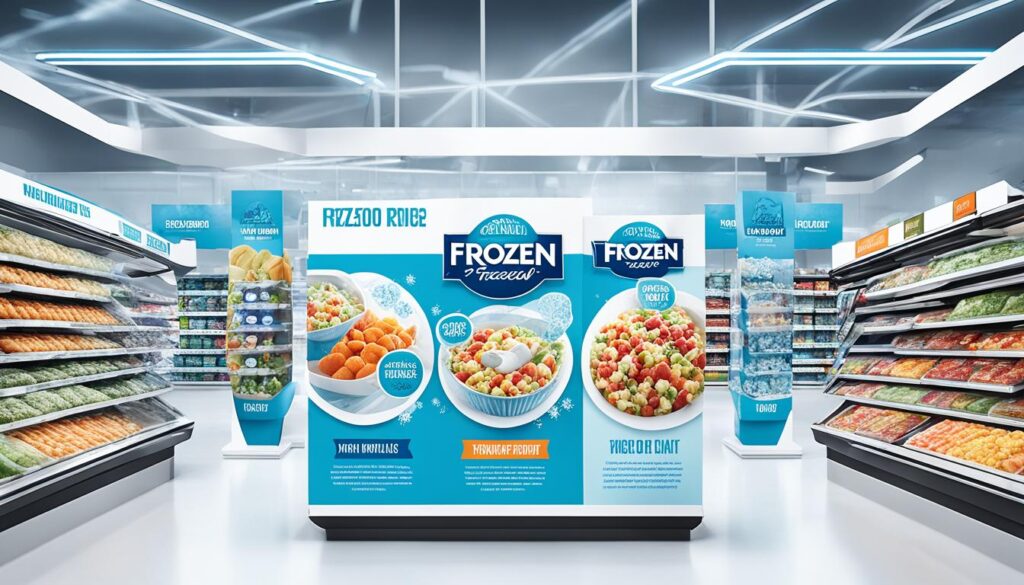Did you know that by 2024, the global frozen food market could hit $376.19 billion? Consumer tastes and habits are changing fast, making the frozen food industry shift. It’s key for both companies and customers to understand the changes happening in this market.
In this part, we will look into what’s pushing the frozen food market in 2024. We’ll study how consumer likes and actions are changing. Then, we’ll share what this means for the frozen food market’s path ahead.
Key Takeaways:
- The global frozen food market is projected to reach a valuation of $376.19 billion by 2024.
- Consumer preferences and behaviors are driving significant changes in the frozen food industry.
- Understanding consumer trends is crucial for industry players to meet evolving demands.
- Predictions for the future trajectory of the frozen food market are essential for decision-making.
- Stay tuned to uncover the latest insights on consumer trends and the future of the frozen food industry in this article.
Emerging Patterns in Global Frozen Food Consumption
The global frozen food market has seen big changes recently. People’s preferences and how they buy frozen food have evolved. Knowing these new trends is key for companies. They need to adjust their plans to keep up with what customers want. We’ll look at three important trends here: the rise in frozen meals, a move to buying frozen food online, and how COVID-19 changed what people buy.
Increased Adoption of Frozen Convenience Meals
Life is busier than ever, which has made quick meals more popular. Frozen meals are easy for anyone to heat up. They’re also getting better in quality. These meals are now a common choice for many families around the globe. As our need for quick meals grows, so does the variety of tasty, healthy options available.
Shift Toward Online Frozen Food Shopping
Buying frozen food online is becoming the new normal. E-commerce sites make it easy. They offer a huge variety, easy delivery, and comparisons. The pandemic speeded up this change. Online shopping was safer during lockdowns. As a result, more people started getting their frozen food this way.
Impact of COVID-19 on Frozen Food Purchasing Habits
COVID-19 changed how we shopped for frozen food. It pushed many to think about easy-to-store foods like frozen goods. People stocked up to avoid going out too much. They also found new ways to cook at home. This led to a big interest in frozen ingredients. Ready-to-eat frozen meals also became very popular.
Even as life returns to normal, some changes will stay. People now see the benefits of frozen foods more clearly. They look for them more often. The demand for these products is expected to remain high.
| Trends | Description |
|---|---|
| Increased Adoption of Frozen Convenience Meals | Driven by busy lifestyles and the need for quick and easy meal options |
| Shift Toward Online Frozen Food Shopping | More consumers opting to purchase frozen products through e-commerce platforms |
| Impact of COVID-19 on Frozen Food Purchasing Habits | Surge in demand and changes in consumer behavior during the pandemic |
The Growth Trajectory of the Frozen Food Market
We are looking into the frozen food market’s growth pattern. The need for easy and quick meals is getting higher. Many are looking for ways to save time. As a result, the frozen food business is growing fast. This growth is also due to changes in how people buy food. Plus, there have been many improvements in how food is frozen and packed.
We will also look at how big the market is now. And how much it could grow. Knowing this helps everyone in the market. They can make smart choices and take advantage of the good things happening in this area.
By checking the latest trends and what people want, we learn a lot. This includes looking at new technologies. We understand more about where the frozen food market is going. This helps companies to plan ahead and win in the market.
Looking ahead, we must think about shoppers‘ choices. New parts of the market are also important. And we can’t forget about the money side. All these things together give us a full view. They show us where we could do well by investing and making good choices.
Private Label Frozen Food: An In-Depth Analysis
This section dives deep into private label frozen food within the frozen food world. Private labels have become very popular as they offer budget-friendly options. We’ll look at how much of the market they have, how fast they’re growing, and what people think about them.
First, let’s talk about the market share of private label frozen food. These brands are gaining more attention. They have a big piece of the market, according to studies.
Also, private labels are growing quickly. People are looking for deals that don’t skimp on quality. Private label frozen food meets this demand by offering good prices and still being tasty and healthy. This trend is good news for both sellers and makers of frozen food. It lets them offer more products that match what people are looking for.
Consumer view is key to private label frozen food’s success. These aren’t seen as low-quality anymore. People trust these brands for their quality and good prices. This change in how people see these products has helped them become more popular.
„Private label brands have gained significant traction in the frozen food industry, capturing a considerable market share and showcasing remarkable growth potential.“
To get a full picture of private label frozen food, we need to look at what the big players do. We will study how they enter the market, their new products, and how they price things. This will show us what makes private label brands successful. Plus, it will help us understand the industry better. We’ll see what makes private label frozen food products grow and do well.
In the end, private label frozen foods are making a big impact. They have a big market share, are growing fast, and people like them. With good understanding and effort, those in the industry can match what consumers want. This makes it easier for them to offer what people are looking for.
Consumer Preference for Frozen Ready-To-Eat Meals and Snacks
In our quick-moving world, being convenient is key for many people, especially those with busy schedules. That’s why the demand for frozen ready-to-eat meals and snacks is going up. These foods are quick and easy, making them perfect for anyone looking for a tasty meal without a lot of prep time.
Frozen meals are a hit because they’re so easy. Many struggle to find time to cook from scratch. With frozen options, you skip the meal planning, grocery trips, and cooking. Just pop them in the freezer, heat them up when you need, and eat. It’s a simple way to enjoy food that makes sense for today’s on-the-go life.
People love the variety that frozen meals and snacks offer. You can find everything from hearty dinners to light snacks, meeting any taste or dietary need. So, whether you want a traditional dish like lasagna or a veggie-loaded stir-fry, there’s something for everyone.
Moreover, these meals keep their taste and quality even after they’ve been frozen. Thanks to advancements in how we freeze food, these meals stay just as delicious as when they were made. This way, enjoying your meal is always a pleasure, just as if you cooked it freshly.
Market studies show a big growth in the frozen food market is on the way. More people wanting easy meals plus ongoing improvements in the frozen food industry will boost this market. This shows that frozen meals and snacks are here to stay as popular choices.
With so many wanting meals that save time, frozen foods are clearly a great choice. They offer a mix of convenience, variety, and quality. For anyone wanting a fast and tasty meal, these products are a top pick.

Role of Technological Innovations in Frozen Food Manufacturing
This section explores the impact of new tech in making frozen foods. It’s changed how we make these foods, making sure they taste great and are easy to use. The two main areas where we see innovation are in how we freeze the food and in the way we pack it.
Advancements in Freezing Techniques
Freezing is vital in producing frozen foods. Thanks to technology, we now have better ways to freeze foods. Blast freezing and individually quick frozen (IQF) methods are two examples. These methods freeze food super fast, keeping its nutrients, texture, and taste.
Blast freezing uses very low temperatures to freeze food quickly. IQF means freezing each piece of food separately. Because of these methods, frozen foods stay high-quality and tasty. This makes eating frozen meals a good experience for consumers.
Improvements in Frozen Food Packaging
Innovations in packaging are also key. They’ve made frozen foods last longer on the shelf, making them more convenient and attractive. New packaging materials and designs help stop freezer burn and keep food fresh. This makes food safer. Plus, it’s easier for consumers, with things like easy-to-open packages and containers safe for the microwave.
This better packaging not only saves food quality but also helps the environment. It cuts down on food waste and supports a more sustainable future. So, thanks to packaging improvements, consumers and the planet both win.
Tech keeps making the frozen food business better. Innovations in how we freeze foods and how we pack them make sure they’re the best they can be. This means people everywhere can enjoy frozen meals that are high in quality and easy to use.
Key Players in the Frozen Food Industry and Their Market Strategies
In the frozen food industry, knowing the top players and their strategies is key. Looking at what the top companies do shows us how the market works and why they’re successful.
Nestlé is a big name in the frozen food world. They offer a variety of frozen meals, snacks, and desserts. Their strategy is all about making new, high-quality foods that people love.
Conagra Brands is also a leader, with brands like Healthy Choice and Marie Callender’s. Their plan is to make lots of different frozen meals and snacks for all tastes and diets.
Kraft Heinz is known for favorites like Ore-Ida. They focus on making great products that are also affordable. This strategy has made them a go-to for tasty, easy frozen foods.
To stay ahead, these companies work hard on new products, how they look, and getting them out there. They put a lot into research to make things people want. Plus, they work on standing out and keeping customers happy with their marketing.
Getting their frozen foods to stores and online is another big deal. They team up with sellers to make sure you can find their products easily.
Market strategies of key players in the frozen food industry are focused on product innovation, branding, and efficient distribution networks.
Looking at what key players do gives us lots of insight into the frozen food business. Knowing their strengths and weaknesses helps other companies make smart moves. This keeps them competitive in an ever-changing market.
Geographical Hotspots for Frozen Food Growth
This part looks at where frozen food is growing the most. We focus on North America, Europe, and Asia-Pacific. Each place has its own unique market forces affecting frozen foods.
Market Dynamics in North America and Europe
The frozen food market has boomed in North America lately. This is thanks to people wanting ease and good quality. It leads to a boom in various frozen foods. In Europe, growth is also frosty with it. They too love the quick and quality meals found in the freezer aisle.
Both places see diverse needs pushing the market. Consumers love trying foods from all over. They also want meals that save time. This makes private labels and sustainability efforts key. But let’s not forget the cool tech used to freeze and pack these foods.
Asia-Pacific’s Increasing Influence on the Frozen Food Sector
Asia-Pacific is getting a bigger slice of the frozen food pie. More people, cities, and changing tastes are to thank. This all fuels the frozen food frenzy. It’s also driven by a love for Western foods and rising incomes, making a growing middle class.
Having more frozen foods in stores helps. And they’re made to please local tastes. Plus, values on food safety are high. All of these are making Asia-Pacific a big name in the frozen food world.
| Geographical Region | Market Dynamics |
|---|---|
| North America |
|
| Europe |
|
| Asia-Pacific |
|
Consumer Behavior Analysis and Purchasing Drivers
This part looks into why people buy frozen food. We study how things like the price, ease of use, health, and being good for the planet affect what they pick. This helps us see what matters most to people when they choose frozen food.
When picking out frozen food, the cost is a big deal for many shoppers. They like to find deals and compare brand prices. The price often links to how good they think the food is.
Being easy to use is a key reason why folks buy frozen food. Our lives are busy, so we look for meals that are ready fast. Frozen dinners and ready-to-heat options are popular for this reason.
Health is also up there on the list for why people might choose one frozen item over another. More folks are thinking about what they eat these days. They prefer foods without too many extra ingredients, maybe even opting for organic or allergy-free ones.
More and more, people are thinking about the planet when they shop for frozen goods. They like to support brands that do good things for the earth. This could mean less waste, being big on recycling, or sourcing ingredients in respectful ways.
- Pricing
- Convenience
- Health considerations
- Sustainability
Understanding what motivates people to buy frozen food helps companies make better products. They can focus on what consumers care about most, like making foods that are budget-friendly, easy to prepare, and good for you. Plus, by being kind to the planet, these companies can attract even more buyers.
Impact of Economic Factors on the Frozen Food Market Expansion
We’ll look at how economic factors affect the frozen food market. Economic conditions are very important. They shape how people act and change what’s popular in the market.
Understanding how the economy connects with frozen foods gives us clues. We can see what might come in the future, good or bad.
Assessment of Employment Trends and Disposable Income
Employment’s level makes a big difference in the frozen food market. When unemployment is low and jobs are growing, people have more money to spend. This includes buying more frozen food.
But when there are fewer jobs and unemployment is high, people have less money to spend. This could mean they buy more frozen foods. They are affordable and still good quality.
Looking at how jobs and money affect what people buy is key. Companies in the frozen food business should adjust to these changes. They can then better meet what their customers want and need.
Influence of Urbanization on Food Consumption Patterns
Urban living changes how and what people eat, affecting the frozen food market. As more people move to cities, what they eat changes. This is due to different lifestyles and demands.
In cities, life is often quick, and there’s little time to cook. Frozen meals become a go-to for many. This is especially true for people living alone or with both parents working. For them, quick and ready-to-eat foods are a must.
Because of these changes, companies need to adjust their products for city dwellers. Doing so can help them grow their share of the market. They can offer foods that meet urbanites‘ needs, like quick and easy to make meals.
The frozen food market is greatly affected by economic factors. Understanding these forces is crucial for companies. It helps them make smart choices and craft strategies for success in this dynamic sector.
The Role of Supply Chain and Distribution in Frozen Food Accessibility
To make sure people can get frozen foods, we need to look at how they are moved around. The whole process includes keeping, moving, and giving out the foods to stores and people. By making this process better, companies can give more people the frozen foods they want.
First, the journey of frozen foods starts with picking the best raw materials. These are then processed carefully to keep them fresh. Next, the food is frozen and stored in special places to stay fresh and tasty.
Getting the frozen foods to stores is really important. They must be moved in cold conditions to stay good. Special trucks and containers with coolers are used for this job.
When the foods get to stores, they must be kept in special freezers. This keeps them from melting. Stores do their part by making sure the foods are available and look nice for customers.
Technology has also made it easy to buy frozen food online. Now, people can order and get frozen food sent to their homes. This change has made it more convenient for everyone to get the food they like.
Optimizing the supply chain and distribution is vital in meeting the growing demand for frozen food products and ensuring their accessibility to consumers.
In the end, how we move and share frozen foods is key to everyone being able to get them. Managing where they are stored, how they travel, and reaching customers is an important job. With new tech, this system is getting better, making frozen foods more available than ever.
Analysis of Market Segments: Organic vs. Conventional Frozen Foods
In the frozen food world, knowing what customers want is key to success. This study looks at two big groups: organic and conventional frozen foods. We’re digging into what people think, who’s buying what, and what’s growing fast.
Consumer Perception of Organic Frozen Produce
More and more, shoppers are picking organic frozen fruits and veggies because they think it’s better for them. They like that it’s grown naturally and without harmful chemicals. This method also catches the eye of those who support eco-friendly farming.
„I prefer organic frozen foods because I believe they are healthier and more nutritious. I trust that they are produced using natural methods and do not contain harmful chemicals.“ – Mary, organic frozen food consumer
Organic frozen choices fit well with a desire for simple labels, clear sourcing, and overall health. Being certified organic adds another layer of trust for many buyers.
Comparison of Market Share and Growth
The organic corner is growing, but traditional frozen foods still sell the most. However, more people are choosing organics, so their slice of the pie is getting bigger.
| Market Segment | Market Share | Growth Rate |
|---|---|---|
| Conventional Frozen Foods | 70% | 3% annually |
| Organic Frozen Foods | 30% | 10% annually |
Despite being smaller now, the organic group is growing quickly. More folks know about organics, like the taste, and find them more often in stores.
The trend is healthy, sustainable foods are a top choice for many. This points to more growth for organic options and a challenge to the traditional way of doing things.
For businesses in the frozen food biz, understanding these trends is crucial. Knowing the rise in demand for organic goods helps in making better products. It also improves how these goods are sold and distributed, helping grab more of the market.
Predictive Trends: Frozen Food Market Forecast for 2024-2031
In this part, we’ll look at what’s coming for the frozen food market up to 2031. We’ll check out the expected growth rates and market sizes. This info will help see where to possibly invest. We’ll also point out areas in the frozen food market that are likely to do well.
To see the future growth rates and market sizes, look at the table below:

The table shows how the frozen food market might grow between 2024 and 2031. For those wanting to invest, these numbers are very useful. They indicate possible growth areas in the market.
The forecasted data highlights a few sectors that could be good for investment and growth. Here are some areas worth considering:
- 1. Frozen Ready-to-Eat Meals: The frozen meals you can quickly heat and eat are becoming more popular. They are a big hit with people wanting easy meal options. This trend is likely to keep growing.
- 2. Organic and Health-focused Frozen Foods: More and more people are looking for healthy and organic food. Investing in this type of frozen food can meet the growing demand. It’s a chance to provide what health-conscious consumers want.
- 3. Online Frozen Food Sales: Like with other products, buying frozen food online is increasing. Companies that focus on online selling and smart marketing can reach more customers. This can help grow their business.
For companies wanting to grow, investing in these areas can be a smart move. They can take advantage of the expected growth in the frozen food industry.
Conclusion
After diving into trends and market growth, it’s clear the frozen food market is changing fast. People love meals that are quick and easy, which has boosted demand for frozen meals and snacks. COVID-19 made online grocery shopping more popular, changing how we buy frozen foods.
The big companies in this field are keeping up. They’re using new tech for better freezing and packaging. This means the food is tastier and looks better. Also, store brands are now big players, offering lots of different frozen foods.
The frozen food scene will keep growing, thanks to more money, city life, and what consumers want. More folks are looking for organic options that are good for them and the planet. This opens up chances for more investment and success in the market.
To wrap up, the frozen food market is changing to fit what people want today. By following trends, using new tech, and knowing the market well, businesses can do really well in this fast-moving and competitive place.

